While researching the pet turtles for your home aquarium you find out that they are noticeably messy.

Naturally, your hunt for the best and most reliable filter for your new aquatic turtle tank begins here.
Could it be the external canister filter, which is powerful and quiet? Or you could get away with an internal HOB filtering system?
Let’s suppose your Red-eared Slider will inhabit a 55-gallon tank. You’ll need to take the setup and size of the tank into consideration before making a decision. What you’d want is an adequate water turnover to keep the turtle aquarium clean.
In this article, I’ve put together some detailed recommendations to help with that.
So given all the personal circumstances, what’s the best and most efficient filter for aquatic turtle tanks, and how to choose yours?
See Also: The 14 Types of Freshwater Turtles: The Best Aquarium Companions for a comprehensive list of the most popular pet turtle varieties!
Top 7 Turtle Tank Filters – Overview
| Filter Model: | Recommended for: | Price Bracket: |
|---|---|---|
| 1. Eheim Classic 22(xx) Series | 20 to 30 gallon tanks | $ |
| 2. Penn Plax Cascade Canister Aquarium Filter | 20 to 45-gallon tanks | $ |
| 3. Fluval 07 Performance Canister Filters | 30 to 55-gallon tanks | $$ |
| 4. Fluval FX Series Filters | 75 to 125-gallon tanks | $$$ |
| 5. Aqueon QuietFlow Canister | 30 to 55-gallon tanks | $$ |
| 6. Eheim 2262 Aquarium Filter | 125 to 150-gallon tanks | $$$$ |
| 7. Eheim Pro 4+ | 30 to 65-gallon tanks that are full of water | $$ |
What You’d Want in a Filter for Your Turtle Tank?
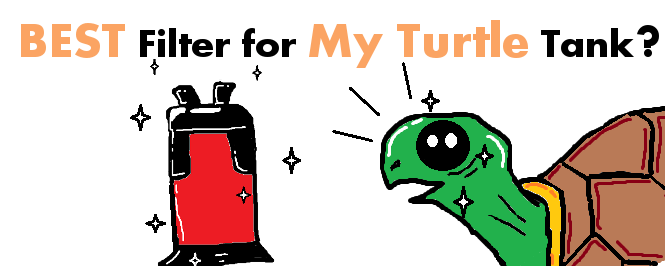
1. Canister Filters Are Superior to HOB and Internal Filters
To be honest, I’ve seen a few turtle tanks that ran successfully on HOB filters, but they were understocked and the turtles were very small juveniles.
Eventually, my friends did upgrade to a external canister filter. All they say after the upgrade is that they won’t ever go back to Hand-on-Back filters for their turtle tanks.
And external filter is one that is placed outside of the tank. A canister filter is one that literally has a canister (also known as cartridge) where you can put fitler media. All canister filters are external.
So here’s why canister filters are superior and a preferred choice for turtle habitats:
Canister aquarium filters are made of relatively large cartridges that can hold a ton more filter media than a regular HOB filter.
They are also external in nature and are placed beneath the tank, in your stand’s cabinet.
This is quite important if you appreciate in-tank aesthetics.
A canister filter is also equipped with stronger impellers and motors, providing the best aquarium filtration on the market, which makes them an ideal choice for a messy aquatic turtle.
I have a reviews article that lists the best aquarium canister filters out there.
However, it revolves more around fish tanks.
The beginner guide you’re reading right now is 100% focused on turtle habitats in home aquariums and I give additional options for the different possible setups so you should likely keep reading here.
2. The “x8 Rule”
If you’ve ever owned a decently-sized fish tank you’d know how crucial filtration is for carnivorous aquatic inhabitants.
Imagine the messiest 10-inch long Oscar (a semi-large aquarium fish) that feeds on live fish only and produces mad waste all over the aquarium.
Well, multiply that by 2 and you’ll understand how turtles can be.
Aquatic turtles are extremely messy creatures and demand a severe level of care for their aquarium water.
It’s not unseen for turtle parents to compromise with their tank’s filtration, which leads to smelly, green tank water that has the distinctive swamp stench. Cloudy white water caused by bacterial blooms is also not out of the question.
Aside from being disgusting, this is also quite unhealthy, because it gives way to various non-wanted microorganisms.
To avoid all of this, the hobby generally agreed upon the “x8 rule”.
The x8 Rule states that if you own an aquatic turtle pet, the aquarium filter that you set up should turn the available quantity of water in the tank at least 8 times PER HOUR.
It’s easier to remember it that way, and I’m honestly tired of seeing people wasting money on the wrong turtle filter, just to come back in a couple of months to buy a stronger one.
The more hobbyists who learn about the “x8 Rule” and remember it that way – the better for everyone involved, including their pet turtles.
Author’s note: In the fishkeeping world, the rule is set at around 6 water cycles per hour, but for overstocked tanks or turtle-inhabited tanks, it rises to 8 times per hour (sometimes more…).
3. With or Without a Basking Area for Heat and UVB Lamps
Another thing that I never see taken under consideration in those other guides online is the setup of the turtle tank’s owner.
In the turtle-keeping world, it’s generally considered a good idea to provide your pet with a basking area. Turtles are cold-blooded creatures and as such they require their daily sunbath under special heat lamps and UVB light bulbs.
For turtle tanks, there are 3 setups that influence the pick of an appropriate filter:
- An aquarium that’s filled with water to the top;
- An aquarium that has a basking area inside the tank and is only filled halfway through with water;
- An aquarium that’s filled to the top and has a separate above-tank basking area.
Quick and obvious takeaway:
There are different quantities of water to be filtered. It’s one thing to filter a 100-gallon turtle tank that’s filled to the top. But you’ll need a completely different water filter for a 100-gallon tank that only has 50 gallons of water in it.
This brings me to the next section…
4. Advertised GPH vs Real GPH
GPH stands for Gallons Per Hour and is meant to represent how many gallons of water pass through your filter every hour. This is also sometimes called “flow rate”.
Every aquarium filter that I’m about to list in this artilce has its own advertised GPH flow rate.
Some will have 100 GPH, others will have 500+ GPH ratings.
So let’s make a quick reference to the “x8 Rule”.
The x8 Rule is only concerned with the ADVERTISED flow rate.
Let’s take a practical example:
So why’s the turnover number so high? I mean 8 times seems crazy for a 55-gallon aquarium, right?
You’d be absolutely right…if the number was realistic.
Here’s what you should know about how advertised GPH flow rates compare to real GPH rates of aquarium filters:
When manufacturers measure the GPH potential of their aquarium water filters they do not include filtering media, livestock, and decor in the test.
This is done to artificially increase the advertised flow rate (though technically the number is not untrue). On average the real GPH would be about 50% of the advertised GPH, which is completely normal.
Let’s take the Eheim 2262 for example.
This is the best filter for very large turtle tanks in my opinion and I’ve explained that in my reviews below.
So the Eheim 2262 has a supposed pump output of 900 GPH.
Mind that this is not the same as the GPH rating of the filter itself, but rather its pump.
Anyway, It’s one of the strongest pumps of a canister filter in the aquarium industry. Only the Fluval FX6 canister filter claims the same pump output.
However, doing some proper flowrate testing (link to a forum where some guy actually made the effort) you’ll see that the “real” GPH an Eheim 2262 can sustain is quite lower.
Here’s a summary of the test:
With everything being equal, after a year of not cleaning it, and a cartridge full of media pads the filter reaches a realistic water turnover of 329 GPH.
With this (real) number you can be sure that the turtles in your 150-gallon tank would have a clean environment for themselves.
Full media trays, accumulated gunk, aquarium decor, and even the architecture of the canister filter may impact its flow rate potential in a negative way. For this reason, we (turtle keepers in the hobby) have agreed upon the x8 Rule.
Though based on the advertised flow rate, the rule makes sure that the real number of hourly water cycling will be enough to handle all the turtle waste.
5. The Gallon Capacity of the Tank Should be Considered
This section will be short.
Obviously, different aquarium filters have different water cycling power.
The gallon capacity of your turtle tank plays the most important part in your purchase decision for a filter.
I will ease the pain from hours-long research on different filters and their respective GPH responding to your tank’s gallon capacity. Further down this article there’s a section where I recommend a filter for each aquarium gallon capacity.
There, I’ve taken into consideration everything turtle keepers would need to calculate when buying a filter for their tank:
- the turtle tank’s gallon capacity
- whether the tank is with or without a basking area
- whether the tank is lightly or densely stocked.
Just make sure to check that out if you want a guided decision.
I’ve listed my arguments for every filter recommendation and why it’s probably your best option for the given turtle aquarium setup.
6. How Quiet the Filter Operates
Not everyone can endure the splashing sound HOB filters make when working.
Canister filters (another major advantage of theirs, in my opinion) are the quietest of all other filters available on the market.
It’s all in the technology they employ – everything is done via tubing and there’s no “air time” for the incoming water stream.
I crafted a separate guide that reviews the quietest canister filters on the market. I’m well aware that there are light sleepers among us. Most of the models listed here are included there.
I share my subjective findings in the article I linked above.
If you don’t have the time to give it a skim, know that in my model reviews below I’ll include if a turtle filter is particularly loud.
7. How Often The Filter Needs Cleaning
If you nail a good canister filter (as I’d like to believe are my reviewed recommendations below) you’ll enjoy minimum cleaning of the cartridges.
The more media the filter holds – the less frequent opening and cleaning it will require. This is yet another reason I only recommend getting a canister filter for your aquatic turtles.
It usually takes me from 10 to 20 minutes to clean out mine, which is not a lot by any means.
Still, the process is not something that you can do while microwaving the breakfast so keep that in mind.
8. The More Space for Filter Media – the Better
The second most important feature of the possibly best turtle filter is the amount of media the filter’s cartridge can hold.
The power of the output pump would be nothing without a decent amount of mechanical, biological, and chemical barriers for all the nasties that get circulated in the turtle aquarium.
The canister filters I’m reviewing here provide immense space for filtering media.
Most of them will have more than one stage of filtration, in the form of multiple media trays.
Some of the models below will come with their own pads and some will be delivered to you empty.
Anyway, with aquatic turtles, you’ll want a huge amount of biological filtration so that the aquarium can remain cycled at all times. A cycled aquarium can handle the copious amounts of ammonia and nitrite that are released in the water through turtle waste and leftover food.
Another thing you’d want to pay attention to is the physical gunk that will build up in your filter’s media.
If you’re smart about it you’ll want to research deeper into mechanical filtration and a certain solution will come up more than once.
It’s called filter floss.
You can visit this article link to check my post where I discuss the thing in detail.
To summarize filter floss: Filter floss is a super-duper inexpensive way to achieve crystal clear water in your aquarium be it a turtle or a fish tank.
Make sure you check that article to save yourself some headaches in the future.
The Best Filter for a Clean Turtle Tank: Reviews of my Top 7
The best and most efficient turtle filter should be equipped with a strong pump. It should also have plenty of internal chambers for good mechanical and biological filtration.
For this reason, it shouldn’t be surprising that I’ve only reviewed canister filters below.
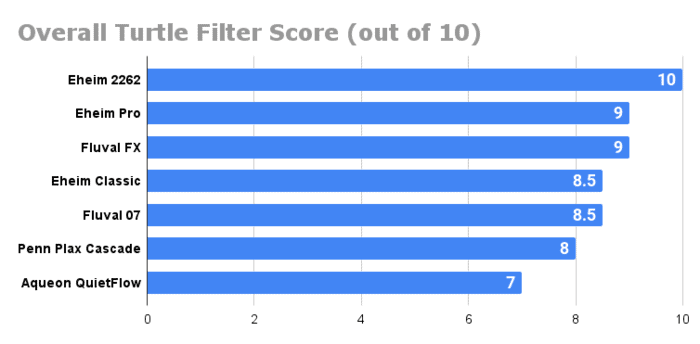
They are more robust, pump a lot of water, and are also more durable than their HOB counterparts.
That being said, here are the best filters for clean aquatic turtle tanks:
1. EHEIM Classic – Long-term Game
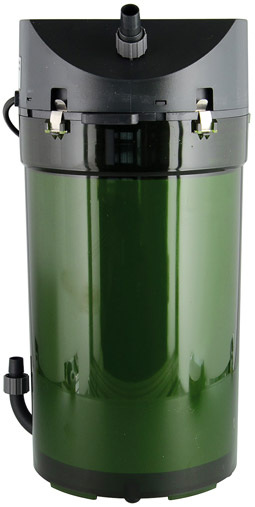
Click to compare pricing + see MORE photos of this product at:
Ever since their German manufacturers dropped them on the market the Eheim Classic canister filters have had a solid reputation among aquarium keepers.
I guess the engineers in that country are not only famous for creating quality cars.
When you purchase an Eheim Classic canister filter you’re essentially claiming that you’re serious about your pet’s aquarium filtration.
Why?
One of the best reasons would be that this turtle filter may last you decades.
Eheim’s only rivals in terms of durability are probably the filters made by Fluval, but more on that later.
Eheim still holds first place in longevity, at least in my humble opinion.
Anyway, the architecture of the cartridge makes sense when it comes to everlasting filtration because the build is simple but efficient.
The impeller and the motor are well-built, ensuring thousands of hours of continuous work.
The Eheim aquarium filters are also super quiet when working.
I did list them as #1 in my “silent filters” reviews, to which I placed a link earlier in this article (under the Noise section in the beginner’s guide).
This automatically makes the Eheim Classic canister filters suitable for light sleepers who keep their turtle aquarium in the room where they sleep.
Another thing I would like to mention about these turtle tank filters is that their architecture allows for the least reduction in flow rate after all the media has been introduced in the trays.
This is very important, especially in turtle tanks, because they get polluted very quickly and timely water treatment is essential.
By the way, Eheim also made sure that your electricity bills won’t skyrocket once you plug in their product.
I am unsure how they managed to pull that one off given the advantages I listed above.
These canister filters have optimized power consumption, which can be a dealbreaker for aquatic turtle pet owners in the long run.
Combine that with Eheim Classic’s unseen durability (not even exaggerating here) and you have yourself one of the best water filters for a clean turtle tank.
The only disadvantage that’s worth discussing is these filters’ GPH ratings.
The Eheim Classic Series is mainly targeting smaller turtle tanks, and we all know how fast turtles can grow.
If you keep a smaller turtle species then this canister filter is for you.
If you plan on upgrading in the near future I would suggest looking into a stronger unit for your turtle aquarium.
In my custom recommendations guide further below, I explain this in detail.
Make sure to check that out so that you can confirm if this canister filter fits your turtle’s needs.
Anyhow, the manuals kind of suck, but I’ll leave a link to a YouTube guide on how to assemble the whole thing.
The motor’s only disadvantage is that it will not prime itself automatically (as other units on this list will).
And one last thing – I consider the Eheim Classic Series to be among the easiest canister filters to maintain and clean. Given the messy nature of aquatic turtles, this may be one of the best qualities of this filter.
I’d rate the Eheim Classic as an overall no-brainer purchase for smaller turtle tanks.
Advantages:- Will last you a VERY long time
- Comes with all-purpose filter media when ordered online
- Permo-elastic sealing
- Tons of space for media
- Maintenance is easy and time-saving
- Fast and easy assembly
- Is super quiet
- Lower GPH for its price tag (but longer contact between water and filter media, thanks to the huge cartridge)
- Useless setup manual (here’s a video for proper installation)
2. Penn Plax Cascade Canister Aquarium Filter – TOP rated
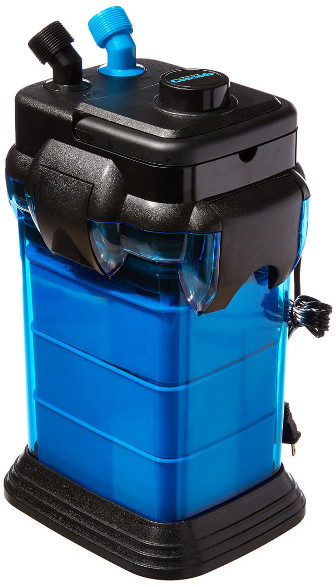
Click to compare pricing + see MORE photos of this product at:
The first thing you’ll probably notice when browsing the Cascade Series on Amazon or Chewy is the huge amount of positive reviews.
To best describe it, I jokingly call this brand the People’s turtle filter.
The people reviewing the Cascade Series, however, are not joking when they evaluate their experiences.
These aquarium canister filters are usually on sale with a huge discount and provide tons of filtration for the money.
The Penn Plax Cascade filters come in a wide variety of sizes, which combined with their price point, makes them one of the best choices for maintaining a clean tank habitat for aquatic pet turtles.
You can read more about the tank size in which these units will fit best in my guide below the review section.
Anyway, by getting a Penn Plax you’re essentially paying less for more. You get a strong pump, a lot of customization, and a sturdy but somewhat unappealing design.
Aesthetics aside – you can just stick the canister filter in the cabinet beneath your turtle tank.
Because of Penn Plax Cascade’s customizable flow rate, it’s a smart move to get a larger-than-needed filter if you can afford it.
This way you’ll be able to upgrade turtle tanks when your pet turtles outgrow the available space without worrying about a new water filter.
If you end up getting a larger filter you can just turn down its flow rate until the time is right to turn it back to more gallons per hour.
Anyhow, let’s discuss the build of the Penn Plax Cascade model.
These filters are NOT made of regular plastic which contributes to the overall durability.
The manufacturers made sure you’ll get a long-lasting product by using some kind of very sturdy plastic material. I am not an expert in that field, but even my untrained eye (or hand) could tell that the Cascade filters would not break in the foreseeable future after my purchase.
The valves that the Cascade canister filter uses are all the rage, by the way.
They can turn at 360 degrees, which is pretty convenient when you’re deciding on your new turtle filter’s place.
There is no spatial restriction, which is seldom seen in the canister filter industry.
Another advantage here would be the staged filter media trays.
You can stuff whatever media you want in all the trays and the largest model is equipped with 5 stages of filtration (the Cascade 1500 Series).
With turtles, you’d want to emphasize biological and mechanical filtration.
Anyway, with a Penn Plax filter, you get a self-priming button as a feature. Not the easiest thing to push, but it definitely eliminates the annoying manual priming.
Also, the manufacturers made sure that the disassembly of the unit is novice-friendly, which makes maintenance a breeze. As I said earlier, this is a great convenience when dealing with turtle tanks.
The instructions are spot on (unlike with Eheim’s products) and very easy to understand. You’ll have a rather carefree time when installing this unit.
The operation is quiet by the industry standards and if you keep the canister inside of a cabinet you won’t ever hear it working.
I’d buy this canister filter for my turtle tank if I wanted to take advantage of the possible customization and am on a tighter budget.
Advantages:
- Adjustable flow rate!
- Spray-bar is included in the delivery (less water disturbance from the incoming outlet)
- Between 2 and 5 stages of filtration, based on the model
- Self-priming feature
- Disassembly is fast and easy
- A special type of sturdy plastic
- Silent operation
- Novice-friendly instructions and installation
- BONUS carbon filter media in the package
- Though durable, it won’t last as long as other established brands
- The handle is not that reliable
- Heavy cartridge
3. Fluval 07 Series – Quiet & Powerful

Click to see the price + MORE photos on Amazon.
If you’re in need of a silent and sturdy canister filter for your turtle aquarium then the Fluval 07 Series are your friends.
The difference between the older 06 and the new 07 Fluval canister filters is that the 07 have a little bit more space for media and are also quieter.
Both are among the best if you’d like to have a quality-made filter for your new turtle tank, but it’s obviously better to get the newer generation if you can afford it.
Anyway, Fluval rivals Eheim in terms of quietness and longevity and are an excellent alternative to them because of that.
However, when it comes to middle-sized turtle aquariums you’ll want the Fluval, because of their powerful output pumps.
Being manufactured by the best US parts, the motors of these canister filters provide an excellent level of water filtration and circulation.
The realistic GPH rate a Fluval 407 can turn is ridiculously high for its price tag.
Anyhow, the company has patented its own sound-dampening technology which makes the 07 (and the 06 for that matter) Series virtually silent.
The architecture and high-quality parts make sure that you have tons of filter media space and a long-lasting turtle filter.
Anyway, Fluval’s magnificence doesn’t stop here. The engineers also came up with the Aquastop valves, which prevent the water filter from leaking during cleaning and maintenance.
That’s a very convenient feature in my experience with canister filter units.
By the way, remember how I mentioned that a filter’s flow rate will get reduced when you stuff it with media?
Well, my observation is that the Fluval canisters get their GPH rate reduced the least upon media introduction (along with Eheim).
When you combine this with their monstrous pumps you get an adequate and safe level of filtration for messy aquarium inhabitants such as your aquatic turtles.
Another thing I would like to point out with these filters is the sealing. A well-manufactured sealing is crucial for turtle tank filters and Fluval actually provides one of the best. I have found that leaks happen rarely and are mainly the result of human error.
Upon proper maintenance (which is not rocket science with these) you won’t ever find your Fluval leaking.
As I’ve pointed out in my general canister filter guide I can’t really find anything worth mentioning when it comes to the disadvantages of the 06 and 07 Series.
One thing that you should probably be prepared for is the way you’ll set this filter up.
If you’re new to canister filters it won’t be as easy, unless you have decent visual guidance.
It’s just that some of the actions are counterintuitive to a first-timer. I will link to a decent video on setting up a Fluval 07 below.
Anyway, I would get my turtle tank a Fluval canister filter if I was willing to pay a bit more, but also appreciated a sturdy build with quality parts and long-lasting results.
Advantages:- Aquastop technology of the valves, making it simple to clean the filter pads
- Soundless work of the motor thanks to its sound-dampening technology
- Extremely durable
- Really good GPH rates for the price
- US-manufactured parts & a quality build
- Impressive space for filter media
- Can be difficult to start and prime if you’re a first-time user (see this video, which solves the problem)

Click to see the price + MORE photos on Amazon.
Fluval was just never satisfied with only making quality filters. They wanted to dominate the market so they ended up manufacturing what’s one of the best canister filters for larger turtle tanks out there.
Fluval’s FX canister filter series are their attempt at that and let me tell you, they did a pretty good job.
The FX series are equipped with something called a Smart Pump which is a technology that will automatically prime these aquarium filters every 12 hours.
You won’t have to worry about trapped air bubbles hindering the filtration and making silly humming noises.
On top of that, the pumps housed in the FX series are some of the best on the market.
The FX6 turns 538 gallons of water per hour.
This automatically classifies it as one of the strongest canister filters, which makes it an ideal choice for large turtle tanks.
I recommend getting this unit for very large aquariums with more than one aquatic turtle in it. You can find more on that below in my recommendations guide.
Anyway, the Fluval FX models come with a sound-dampening feature, which makes their operation super stealthy. You won’t hear a buzz from that water filter, ever.
Speaking of ever, these units will last you a long time, as in I’m yet to see one to stop working before the 5th year.
If you’re cash-smart and own a larger turtle tank then this filter is one of the best options for you.
It’s worth pointing out that the FX Fluval units, be it FX4 or FX6, are a bit pricey, compared to others on this list, but that’s fairly justified.
Buying one will save you tons of money in the future. And with bigger turtle tanks, filtration is not to be compromised.
By the way, did I mention that you get 6 stages of filtration with the FX6?
Six physically huge stages of filtration, that will give your turtle tank more than enough biological filtration to never worry about an ammonia spike or a nitrite one.
You’ll be able to stuff all the media that you’ll ever need inside this monster.
The enormous amount of space for filter media will reduce the need for cleaning to once every 4 to 6 months, even with messy turtles.
Still, whenever the time for maintenance comes, you’ll need to spend at least half an hour on it.
The disassembly is rather straightforward, but because of the large size of the cartridge, it takes time.
The Fluval FX filters come with a built-in, anti-clog feature as well, which prolongs the expected life of the product to virtually forever.
That’s unless something breaks, which won’t happen in the near future after your purchase, because of the high-quality parts used in the build of this canister filter.
Another advantage here would be that the electricity bills for running such a device are impressively low.
The only con of this product is the higher initial payment, as it’s not something that everyone can afford right out of their pocket.
But if you’re someone that has a 90+ gallon turtle tank you were probably prepared for that anyway.
My overall rating for the FX series is an A+ and I’m trying to be objective here.
Well done, Fluval. The FX6 and FX4 canister filters are among the best choices for a decently stocked larger turtle tank.
Advantages:- Smart Pump feature that primes the unit every 12 hours automatically
- One of the strongest pump output on the market
- Power consumption optimized – smaller electricity bills
- Has the most stages of filtration – 6 in total
- Built-in flow rate tracker, automatic flow rate adjustment when needed
- Self-protecting mechanism – will deactivate itself if it detects the potential for a leak
- Silent, despite the huge motor
- Is a long-term approach
- Additional tech features
- Multi-direction nozzle
- The higher price tag (definitely worth it for the provided quality though)
- LARGE cartridge (a decent aquarium stand will still be able to cover it)
- Looks more complicated to install than it is (unless you click here. This is a video with a very decent explanation on how to set this unit up)
5. Aqueon Quietflow – Strong GPH on a Budget
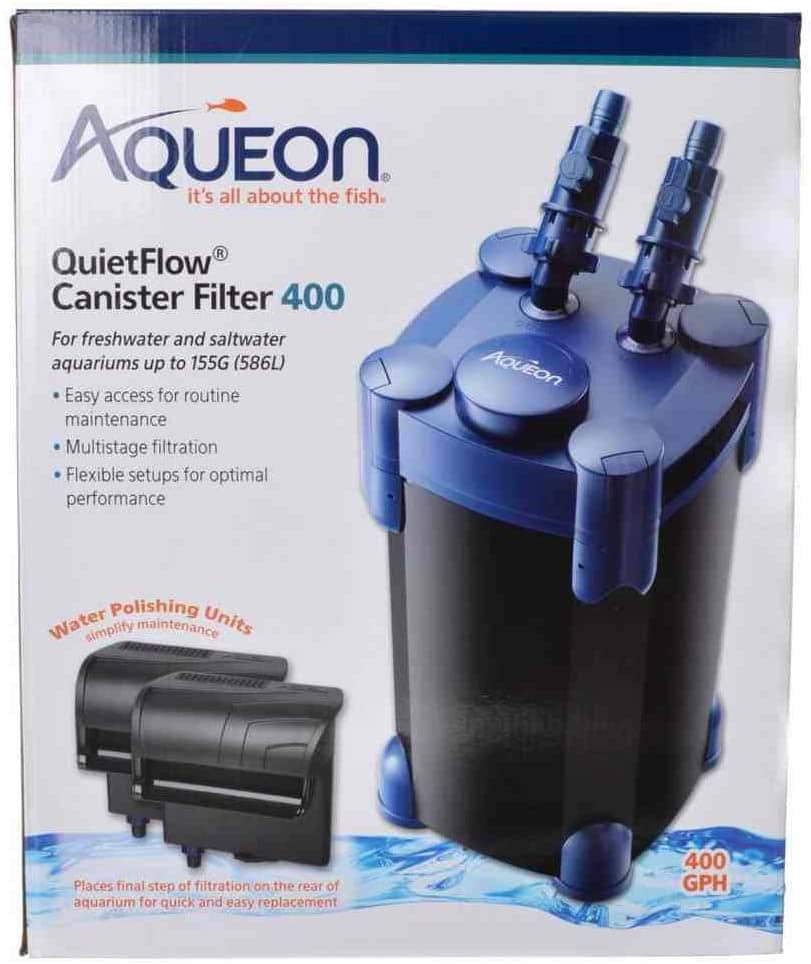
Click to see the price + MORE photos on Amazon.
The Aqueon QuietFlow canister filters are a savvy choice for turtle keepers on a budget.
The Aqueon QuietFlow 400 turns roughly 400 gallons of water per hour and costs a fraction of the premium turtle filters out there.
If your budget is a bit tighter, but you still have a decently-sized turtle tank then this canister filter may be the best option for you.
I’ve found that the Aqueon QuietFlow filters have the strongest motors for this price bracket.
However, power is not their only advantage as they also stand out with many other qualities.
These filters have multiple stages of filtration and the media trays are humongous.
The body of the Aqueon QuietFlow is very robust and the filter operates very quietly once it is primed.
A beginner would find the installation process very easy and straightforward which is a big plus, given how complicated things can get with canister filters.
The tubing is longer than with your usual canister filter, which allows more flexibility with positioning.
One cool bonus you get with the Aqueon QuietFlow Series is their two “water polishing units”.
These are basically Hang-on-back bodies that can be connected to the canister itself and can hold additional media.
In my experience, the best way to take advantage of the water polishing units is by stuffing them with filter floss.
This usually results in crystal clear water in the turtle tank, which I like.
Anyway, what I don’t like about these turtle filters is their weird way of priming.
There are clear instructions on how to do that but it’s a bit difficult anyway. The good thing is that you’d only have to do it once every couple of months during the turtle filter’s maintenance.
Since the media trays are so large you’ll rarely need to open the filter for cleaning.
I would rate these filters at 9/10 because of the priming issue. Given the price tag and the water circulation you get in return, I’d say that getting an Aqueon QuietFlow Canister Filter would be a pretty good deal for a turtle tank owner.
These units are ideal for larger turtle habitats.
Advantages:- Comes with two water polishing units for extra media and easier maintenance
- Excellent performance for the price
- No-brainer installation
- Robust build
- Good durability for the money
- Longer tubing
- A lot of space for filter media
- Quiet, as the name goes
- Somewhat difficult to prime
6. Eheim 2262 – The CHAMPION
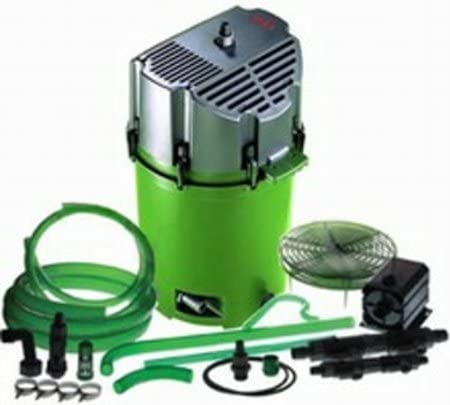
Click to see the price + MORE photos on Amazon.
For many reasons, I consider the Eheim 2262 the absolute best canister filter for large aquatic turtles out there.
This heavy duty canister filter really stands undisputed, though it’s not particularly new to the market.
From what I’ve seen the Eheim 2262 filters outperform even the FX6 but do come with a higher price tag.
They turn over 630 gallons of water on an hourly basis and I’ve actually seen people using them in turtle ponds, which is quite interesting.
These turtle tank filters are also the most reliable systems ever, because of their longevity.
I am yet to see one of these to break and I know people using them for 10+ years.
So what’s the secret behind the unbeatable long-term success of the Eheim 2262 turtle filters?
My assumption is that it’s their sheer simplicity.
With an Eheim 2262, you get a huge cartridge that can hold 4.7 GALLONS of filter media. This allows for a lot of biological and mechanical filtration in even a very large turtle tank.
No other turtle filter has been able to offer such media capacity, which allows us to compromise with the x8 Rule and have this filter on very large tanks.
Also, with such a huge media basket you won’t need to change the filter pads for months to come.
The choice of media inside is completely up to you as you don’t need to buy special customized Eheim media.
I’ve seen people simply stuffing it with biofiltration and filter floss which is honestly enough to maintain pristine water in an aquarium with multiple messy turtles.
Apart from the cartridge, you have high-quality, durable hoses as intake and output tubing, which are doing a fantastic job at keeping leaks at bay.
And finally – you’ll end up with a beast of a pump that’s heavy, quiet, very powerful, and reliable.
Literally, all you could want for a 150-gallon aquarium with aquatic turtles.
And that’s about it – three high-end components that result in brand loyalty from everyone that has ever laid their hands upon this canister filter.
My experience has been that this unit is hotly recommended if you’re in the large turtle aquarium game.
You can read more about which tank size this filter fits best in my recommendations guide below the reviews section.
It’s a very neat solution if you can’t afford the space or handiness to build your own sump.
Anyway, here’s an example video of a fellow aquarium owner that runs 2 of these on his 300-gallon fish tank.
The tank doesn’t contain turtles but has some monstrous Arowana fish and stingrays – a recipe for copious amounts of waste already, because of their carnivorous diet.
I’m assuming that’s enough to persuade you into getting one of these if your aquarium’s size demands it, but let’s also discuss the cons of this product.
First and foremost – the pricing. This is the most expensive canister filter listed in this guide. The initial payment mostly suits the financially liberated turtle owners.
However, if you’re seeking a canister filter for a 150+ gallon tank with more than one turtle you’re probably there already.
Consider this – the Eheim 2262 will virtually last you forever.
If you spread the price for each consecutive year you’ll be using it you’d see that it actually is the most cost-efficient decision for your turtle aquarium’s needs.
The pump consumes an insignificant amount of electricity for what it’s worth as well.
Anyhow, a real con of this monstrous canister filter that I would like to discuss is that it’s heavy.
The cartridge is huge and as you can imagine, when it’s filled with water and used filter media it wouldn’t exactly pass as light. Keep that in mind for when you change the media.
Overall if you end up buying this filter your turtles will love it as it’s a fantastic choice for a larger turtle habitat. You would never find yourself regretting your purchase.
I rate the Eheim 2262 a solid 10/10.
Advantages:- Enormous power and gigantic GPH rate (630+)
- Holds almost 5 gallons of filter media
- You get to decide what media to put inside
- High-end parts and 0 chance of a leak
- Virtually immortal, compared to others
- Can be used on a turtle pond as well
- Least reduction of flow rate with added media
- Higher initial price (Though completely worth it in the long-run)
- Useless manuals ( Just follow this video‘s instructions instead)
7. EHEIM Pro 4+ 600 – Ensures a stable bio filter
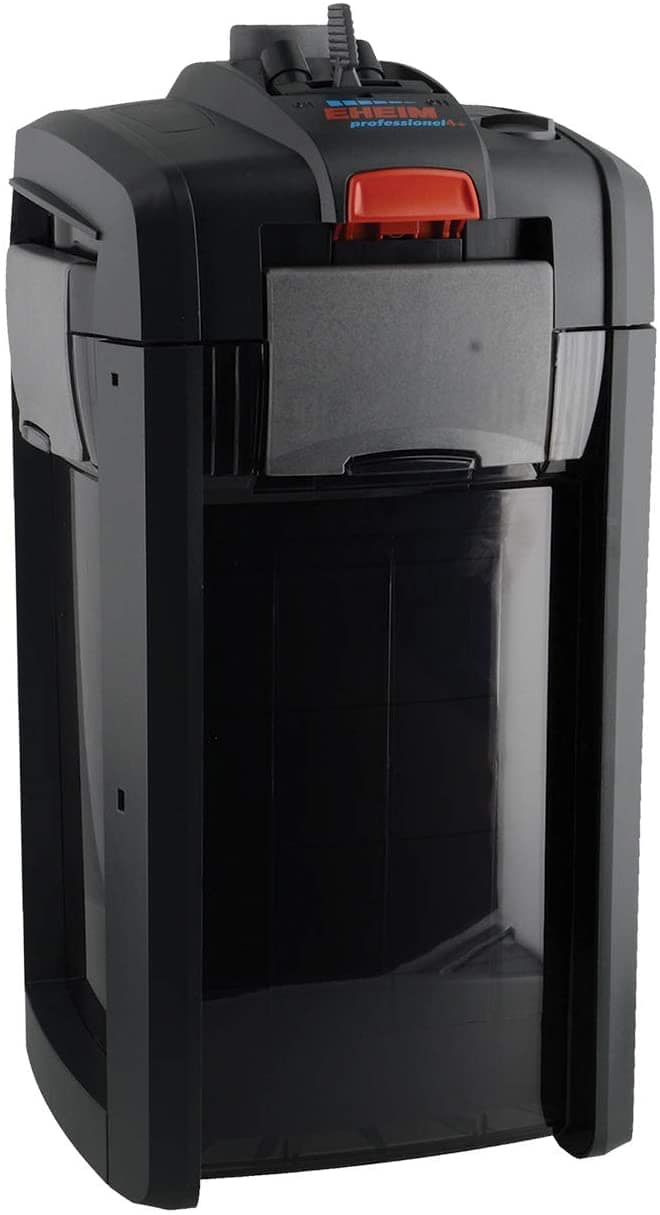
Click to see the price + MORE photos on Amazon.
The Eheim Pro 4+ is a canister filter characterized by its enormous space for filter media, its self-priming feature, and its silent work.
It’s a relatively new generation of Eheim aquarium filters and the manufacturers made sure that it would live up to their reputation.
The Eheim Pro 4+ 600 has roughly 10% more space for filter media than Fluval’s FX6, which is one of the largest canister filters in the hobby.
More filter media means a lot more real estate for beneficial bacteria to settle in.
More beneficial bacteria means that your turtle tank won’t get cloudy or green water and that it won’t smell funny.
With this canister filter, you will have more leeway to clean less often and you won’t need to worry about food leftovers as much.
In my opinion, a strong biological balance is one of the foundations of a successful turtle tank.
Anyhow, the only negative with this filter is that it has a relatively lower GPH rate.
A lower GPH rate means that you’ll be compromising the mechanical filtration if you use it on a larger turtle tank.
Following these thoughts, the Eheim Pro 4+ is perfect for heavily overstocked 30 to 65-gallon tanks that are full to the brim with water.
I would even use it on an entirely filled 90-gallon turtle tank, under the condition that I provide an additional HOB filter to move the water around more.
That’s because, luckily, this filter’s real GPH rate is reduced very little by filter media and whatnot.
So your turtles will enjoy pristine water nonetheless.
Anyhow, aside from its GPH, the Eheim Pro 4+ 600 is pretty much perfect.
I find its Priming pump to be very convenient and starting the filter is super easy.
It works as silent as other Eheim filters, which is one of their top characteristic qualities.
Putting back the media trays together can be a bit weird at first, but you’ll get the hang of it.
Anyway, I also find the Xtender button somewhat useless, but that’s just me.
However, the Xtender button is not what makes or breaks a good turtle filter.
The Eheim Pro 4+ 600 can be a great canister filter for any medium-sized turtle tank and I haven’t heard of anyone who got it and regretted their purchase.
Advantages:- Enormous space for filter media, and therefore beneficial bacteria for your turtle tank;
- Priming and starting it is easy;
- Very silent work;
- Significantly extends the period between cleanings thanks to its design;
- Goes easy on your electricity bills.
- Relatively lower GPH for the price;
- It takes practice to get the hang of the media trays at first.
Which canister filter to choose for your turtle aquarium’s size?
Knowing all the strengths and weaknesses of each particular model and brand is one thing.
However, applying them in accordance with your aquarium’s size and gallon capacity is a whole different story.
In the below guide I’ve taken into consideration pretty much all setups and tank dimensions that a turtle habitat can have.
I’ve then combined that information with the pros and cons of every individual filter that got reviewed above. This allowed me to tailor specific recommendations and save you the hassle of further research. Here are the best filters according to a turtle tank’s gallon capacity:
1. Top filters for 20-gallon turtle tanks
The water filters that would work best on a 20-gallon turtle tank are:
- Eheim Classic Canister Filter 2211 – if the turtle tank is half-filled with water. You can get it over at Amazon.
- Penn Plax Cascade 700 Series – if the turtle aquarium is filled to the top. Compare the pricing of this unit at Chewy and Amazon.
To filter a 20-gallon turtle tank you’d want a water turnover of between 6 and 8 times.
This means a proper filtration unit should be able to maintain at least 120 GPH of flow rate.
This is the safest way to ensure you won’t end up with green, swamp-like water in the first place.
There are two options here – a tank with a basking area that’s half-full (has around 10 gallons of water) or one that has been filled to the top:
A good option to filter a half-full 20-gallon tank with a messy aquatic turtle in it would be the Eheim 2211, which has a maximum water turnover rate of around 60 gallons per hour.
Aside from having suitable power levels, it also runs very silently.
Plus, it’s a long-term approach to turtle tank filtration as these filters are super durable.
I’m talking 5+ years here.
For a 20-gallon aquatic turtle tank that’s filled to the top you’d want a filter that has at least 160 GPH of turnover power:
A durable unit, that’s also easy to install and corresponds to those numbers is the Penn Plax Cascade 700.
Well, it actually has a maximum estimated flow rate of 185 gallons per hour, which is even better.
Though turning the water 9 times per hour may seem a little too much, with a tank of this size you’re faced with the “small tank syndrome”.
This is not a real term, and I just made it up for the sake of the argument, but let me explain.
In a smaller turtle tank, any imbalance in the water parameters can affect its inhabitants way faster than in larger volumes of water.
When it comes to keeping fish, I’d say that the small tank syndrome affects any tank below 10 gallons of water.
However, with turtles and their very unclean ways of living it’s safe to assume that a 20-gallon tank can be considered “small” in that regard.
2. Top filters for 30-gallon turtle tanks
The filters that would perform best in a 30-gallon turtle tank may be:
- Eheim 2211 Classic Canister Filter – if the turtle aquarium is half-full of water. You can find this filter on Amazon.com.
- Fluval 207 External Canister – if the tank is completely filled with water. Have a look at the Fluval 207 over here.
Obviously, to best filter out nasty gunk from a 30-gallon aquarium with aquatic turtles in it, you’d still want a canister filter.
In case you’ve provided your pet buddies with a nice warm place to bathe in UV light and did not fill your aquarium to the top you probably have around 10-15 gallons of water that you’d want to filtrate.
For such a setup my recommendation from above stands:
Use the Eheim 2211 filter as it will be more than enough to turn the turtle tank’s water 4 to 6 times per hour.
Again, you also benefit from the brand name, as Eheim are known for their durability and quiet workflow.
This aquarium filter will keep the water crystal clear easily.
If you are providing a full-blown underwater experience for your aquatic turtle pets I can recommend that you consider getting a Fluval 206 or 207 as your filter of choice.
Both are canister filters that have a turnover of just above 200 gallons per hour, which effectively turns the water in the 30-gallon tank about 7 times per hour.
Fluval 206 and 207 are very well-built, high-end canister filters and from a technical point of view, there are no flaws to them, really.
The only thing I’d consider a con with these Fluval products is the initial setup and priming, as it’s not very newbie-friendly.
Yet, it’s totally doable, thanks to the tons of videos on the subject that one can find online (I provided a link to one such video in my review of the model found earlier in this article).
3. Top filters for 40-gallon turtle tanks
The top filters for a 40-gallon tank with aquatic turtles are:
- Penn Plax Cascade 1200 – a canister filter for an aquarium that’s full of water. Find the Cascade 1200 on both Chewy and Amazon.
- Penn Plax Cascade 700 – get this filter if the turtle’s tank has a basking area and is only half-full of water. Click the links above to see this unit.
A 40-gallon tank is probably the most common one for keeping juvenile Red-Eeared Sliders.
The best filter for a 40-gallon turtle tank that’s filled with water would have a flow rate of at least 240 GPH (40 x 8 = 240). For this reason, I can recommend getting a Cascade 1000 or a Cascade 1200.
The first will spin the water a maximum of 6 times per hour, but that’s with 0 decors and almost no filter media to slow the circulation down.
A much better option for yout new 40-gallon would be the 1200 Cascade model, which nets you around 315 GPH, or roughly 8 times of hourly water turnover.
Penn Plax canister filters are heavily used by beginners and advanced hobbyists alike.
This is understandable, given the price-to-quality ratio of these filters.
The Cascade is affordable and provides champion-like filtration for the money, hence me recommending it for a turtle aquarium.
It’s not as durable as an Eheim or a Fluval, but it will possibly last you and your 40-gallon turtle aquarium for the next couple of years.
For a 40-gallon tank that has basking areas and is filled with water only halfway through you may need to go with a Penn Plax canister filter again, but this time the 700 Series.
In that setup, the Cascade 700 will provide a healthy filtration of around 8-ish full water cycles per hour.
The turtles will be happy and there won’t be a risk of elevated ammonia and toilet-like smell from the turtle tank.
4. Top filters for 55-gallon turtle tanks
The best filters for a 55-gallon turtle tank are canister filters and are the following:
- Fluval 407 – an external filter for a tank that’s filled with water to the top. Check it out on Amazon.
- Fluval 207 – you’d want that filter for a low-water 55-gallon tank with a basking place inside. See this canister filter here, on Amazon.
If you’re planning to have a 55-gallon tank I can bet that you’ll have at least 2 middle-sized juvenile turtles in it, who will generate plenty of waste. Or some medium-sized Red Eared Sliders.
The best way to maintain 55 gallons of turtle water clean is to have a canister filter with one beast of a pump.
For a fully-filled 55-gallon aquarium, this canister would probably be the Fluval 406 or its cousin, the 407, as they have the same GPH turnover.
These monstrous filters have an estimated flow rate of 383 US gallons per hour.
They will effectively turn the 55-gallon tank’s water around 7 times every single hour (383 / 7 = 54.7).
It’s worth noting that all that comes from the Fluval line is high-end quality and a bit pricier.
The price tag, however, is definitely justified as even a tank of this size with 2 turtles won’t be enough to pollute the water inside with that filter.
The aquarium’s water will remain crystal clear and well-circulated, thanks to a powerful motor impeller, that also happens to work quietly.
You’ll get to play with various filter media, as Fluval’s 406 and 407 models have so much space for that.
Anyway, if your 55-gallon aquarium has a basking ramp of some sort and is not entirely full of water, I can recommend the Fluval 206 or 207.
That actually makes sense as these have half the power of the 407.
Still, they have all the bells and whistles you’d ever want in a canister filter for a 55-gallon turtle tank, plus of course – the durability.
Looking after long-living creatures such as the aquatic turtles implies that the best ROI (return on investment) will be achieved by thinking in the long run.
5. Top filters for 75-gallon turtle tanks
To filtrate a 75-gallon tank with turtles the best consider one of the following canister filters:
- Fluval FX6 – Use for a 75-gallon turtle tank that’s full of water. Check the filter on Amazon by clicking here.
- Penn Plax Cascade 1200 – Use that canister filter if the turtle aquarium has a place for basking, and is only half-full of water. Compare deals on this filter at Chewy and Amazon.
There are very few filters out there that can handle a 75-gallon tank with turtles in it alone, especially if the aquarium’s filled with water. PLus, we’re kind of entering adult Red Eared Slider territory here, and they do tend to be messy.
One filter that’s capable of filtering 75 gallons of water, rich in turtle waste, is the Fluval FX6 canister filter.
With an estimated flow rate of 538 gallons per hour this filter successfully executes the rule of the 8-times water turnover, and that’s not only on paper.
The FX6 is a high-end canister filter that is often used in overstocked 90 to 100-gallon aquariums with fish.
However, when it comes to our messier pet turtles who consider “just everywhere” a toilet, the introduction of this model makes sense in my 75-gallon tank section.
I can only assume that in such a system you’ll be keeping one larger or a couple of smaller turtles which is a sure recipe for a “waste” party.
The Fluval FX6 filter comes at a higher price, but you’ll get what you pay for.
In that case, it would be a super strong yet silent motor impeller that’s durable, with quality parts, and hosing. Along with that, you’ll also benefit from a very large space for filter media that you can stuff with biological filtration.
Anyway, the FX6 canister filter is bulky so make sure your turtle tank is on a stand.
Here’s a video of a fellow turtle keeper that has actually replaced 2 filters with a single FX6 and he’s housing 3 aquatic turtles and 2 pretty large goldfish in his 75-gallon aquarium.
Note how he’s saying that with its new one, he only needs to clean once every 2 to 3 months compared to the monthly maintenance of his previous 2 units (insane difference in the required maintenance!).
But what should you get in case your 75-gallon aquarium doesn’t have an above-tank basking ramp and it’s only half-filled with water or so?
Say, that same turtle tank has only 35 to 40 gallons of water that need filtration.
In that case, you can get away with a Penn Plax Cascade 1500 (350 Gallons Per Hour) or a Penn Plax Cascade 1200 with 315 GPH. This filter’s GPH and filter media capacity are ideal for a 75-gallon turtle tank with an internal basking area.
6. Top filters for 90-gallon turtle tanks
The best water filters for a 90-gallon turtle aquarium would be:
- Fluval FX6 Canister Filter – Primary filtration for a 90-gallon turtle tank that’s filled with water. Get it from Amazon.
- Penn Plax Cascade 700 – Secondary filter unit for a 90-gallon turtle tank that’s filled to the top. Get this unit from Chewy or Amazon.
- Penn Plax Cascade 1500 – For an aquarium that has a basking area and therefore is half-filled with water. Use the links above to check this model.
- Fluval 407 External Filter – For a tank that’s overstocked with turtles, but is half-full of water. You can find the Fluval 407 at Amazon.
If you’re a future or the present owner of a 90-gallon turtle tank, that’s filled to the top with water, then you’ll want an established water turnover of 700+ gallons per hour.
Unfortunately, there’s no way around this as turtles are dirty and in a tank of this gallon capacity, you’ll probably have more than one waste producer.
On to the turtle filter recommendations:
Filtering such quantities of water is not an easy job. You’ll need at least 2 canister filters to properly filtrate your 90-gallon turtle tank.
You want to make sure that your turtles will have enough freedom to mess around.
I would recommend buying a Fluval FX6 as your primary filtration system and supplementing it with a secondary, weaker canister filter.
The FX6 will be able to handle around 75 gallons of water with its 538 GPH but you’ll need to enhance the overall performance with another filter that has a proclaimed GPH of around 200.
The secondary unit can be either a Cascade 700 from Penn Plax or a Fluval 206 / 207.
Both are durable and strong enough, though the 207 is slightly better on everything than the Cascade.
Logically, the 206 and the 207 models are also pricier than the Cascade, so just let your budget decide here.
Anyway, what if you have a 90-gallon tank with a basking dock for the turtle’s sunbaths?
Assuming you left around 50% of the 90 gallons empty, you’d want to only filter around 45 gallons of aquarium water volume.
Following the “times 8” rule for healthy water turnover in turtle habitats, you’d want around 360 GPH for this kind of setup.
Penn Plax’s Cascade 1500 canister filter is what you would want to get here.
This device has 350 GPH according to its manufacturers, which will be slightly reduced by the way the water passes through the filter trays.
This will leave you with around 7 times of water turnover per hour.
This may or may not be effective depending on how overstocked your tank is.
If you have just 2 turtles and some not-very-messy fish it may be enough.
However, if you have 3+ aquatic turtles, this alone is enough of a reason to scale to a Fluval 406 or a 407 one.
They both have an estimated flow rate of 380+ GPH, which may sound like overkill, but it’s actually pretty reasonable given the livestock you already have in your turtle tank.
The build of the Fluval canister filters ensures that 100% of the water passes through their media trays, unlike some other devices that supposedly have the “needed” GPH for this particular case, hence me recommending it.
7. Top filters for 100-gallon turtle tanks
The best filters for a 100-gallon tank with aquatic turtles would be:
- Fluval FX6 – acting as a primary canister filter for a fully filled tank. Check the FX6 out on Amazon.com.
- Penn Plax Cascade 1000 – acting as a supplementary filter for a tank that’s full of water. You can get this filter at Amazon.
- Aqueon QuietFlow 400 – for a 100-gallon tank with a basking area for the turtles, that only has around 50 gallons of water. Check out the QuietFlow 400 over here.
Coming from my reasoning in the above section you’d again need 2 canister filters for a 100-gallon turtle tank.
Assuming that your 100-gallon tank is full of water and has no basking area inside you’ll want an hourly water turnover of approximately 800 gallons (100 x 8 = 800).
Though it may sound a lot it’s actually just the right amount for this setup.
As your primary filter, I want to recommend the Fluval FX6.
It’s a top-notch canister filter and it will take care of a large portion, namely around 540 gallons per hour, of the overall needed filtration for a 100-gallon tank.
However, a single unit won’t cut it and you’ll also need a supplementary filter.
Something that comes to mind is the Cascade 1000, which is manufactured by Penn Plax.
It’s a middle-class canister filter that has gained huge popularity since it first came out.
The love of the fishkeeping community for it is absolutely justified, however.
The Penn Plax Cascade 1000 canister filter is built from sturdy plastic, is absolutely customizable, has 3 stages of filtration, and is really easy to maintain.
It turns roughly 265 GPH of water as advertised and it’s probably the best secondary filter for a 100-gallon tank with turtles in it.
If your 100-gallon turtle tank is not filled all the way up with water, because you were kind enough to provide your turtles with a basking space, then you’d need a total of 400 GPH as means of filtration (50 x 8 = 400).
That’s assuming you have around 50 gallons of water available to the turtles.
In that case, a single Aqueon QuietFlow 400 would do.
This canister filter comes with a turnover power of 400 GPH and huge media trays which will be just enough for maintaining a half-full 100-gallon turtle tank clean.
QuietFlow is surprisingly popular among turtle keepers in online communities, so there’s plenty of “social proof” that it’s a quality choice for your setup.
8. Top filters for 125-gallon turtle tanks
The best canister filters for 125-gallon turtle aquariums would be as follows:
- Fluval FX6 Canister Filter – Primary filtration unit for a tank that’s 90 to 100% filled with water. Check this product at Amazon.
- Aqueon QuietFlow 400 – Secondary filter for a turtle tank that’s 90 to 100% full of water. You can see the QuietFlow 400 over here (on Amazon).
- Fluval FX4 Canister Filter – for a turtle tank with a basking dock, that’s 50% filled with water. This is the exact model.
A competent approach to filtering a 125-gallon tank with multiple turtles in it would be to aim for, give or take, 1000 GPH if the aquarium remains full of water at all times.
You can easily reach that by combining two strong canister filters.
I recommend considering the Fluval FX6 as your main filtration system and the Aqueon QuietFlow 400 as a secondary one.
The two of them have a combined flow rate of around 940 gallons per hour.
Both filters are monstrous pump machines that will relentlessly work to keep the tank clean, even with the messiest aquatic turtles inside.
Though two huge filters may sound a little too much, it is hardly the case with turtle tanks, especially large ones.
Also, it should be noted that if you’re having other monsters inside of your 125 gallons, you’ll need even more filtration to be able to provide an adequate living environment for them.
It’s a common practice to stuff 125-gallon tanks with various monster fish and large super messy turtles.
The above canister filter combo is certainly a solid solution for such cases.
Making sure the water in your tank has been turned 7 to 8 times per hour and that it also passes through literal gallons of filtering media is the best and safest approach for that setup.
But what if the turtle tank is only 1/2 full of water because it has a nice sunbathing place for your pet turtles to enjoy?
In that case, we’re probably looking at filtering roughly 60 gallons of water.
Well, with that in mind, a single Fluval FX4 will do an outstanding job at keeping the water of your turtle aquarium crystal clear.
9. Top filters for big 150 to 200-gallon turtle tanks
The best filters for a large 150, 200, or more gallon turtle tanks would be as follows:
- Eheim 2262 – Primary filter for a large turtle habitat that’s 100% filled with water. Check this unit over here.
- Aqueon QuietFlow 400 – Secondary filter for a big turtle aquarium that’s filled to the top with water. Click here to see the QuietFlow 400 and check its price.
- Fluval FX6 External Filter – if the tank has a basking area and is only half-full of water. You can find the Fluval FX6 by visiting this Amazon page.
- XtremepowerUS Pressurized Pond Filter – for VERY large turtle aquariums. See this turtle filter at Amazon.
So far for larger turtle tanks, I was recommending a combo of two canister filters – one primary and one secondary.
The primary always being the Fluval FX6, because of all the horsepower that it’s housing, plus the overall quality.
However, this is not the overall strongest turtle filter.
If you have the bucks to afford it you should be looking at another brand, namely Eheim.
Eheim has a filter that’s actually better than Fluval’s top performer and it’s the 2262 model.
The Eheim 2262 is rated for aquariums of up to 400 gallons (same as the FX6) but the ratings are subjective and based on the manufacturer’s assumptions.
They rarely have anything to do with reality.
Numerous reports and also my personal observation over a couple of clients and friends of mine confirm that the Eheim 2262 is pretty much the best thing out there.
And it’s also the best canister filter to use on a large turtle tank with 150 gallons of volume or more.
On its own, it can handle 2/3 of the required GPH for a 150-gallon turtle tank with some very messy creatures inside.
Still, with a pump output of 900 GPH and an architecture that’s considerably improved compared to the FX6’s one, plus more space for media that provides longer contact between the water and the media, the Eheim 2262 crushes the competition.
Let’s not forget the level of customization you get with it.
The good thing is that the Eheim 2262 will probably last you 10 or more years with good maintenance, outliving its warranty by a multiple.
As a supplementary filter here I would still advise getting an Aqueon QuietFlow 400 though, as in my above recommendation.
This filter nets you around 400 GPH so the combination of both will give your turtle tank the needed hourly turnover for a well-sanitized home aquarium.
For a 150-gallon turtle tank that has a basking area and is halfway filled with water, a single Fluval FX6 will be enough.
For a 200-gallon or larger turtle tank, perhaps canister filters won’t be enough.
I’ve seen somebody pulling it off for his 200 gallons with a single Eheim 2262, but the tank was somewhat understocked.
He only had 2 aquatic turtles in it and the rest of it was large fish, but still not enough to fill the bioload capacity of a 200-gallon aquarium.
You could always get two of these canister filters and call it a day, but that’s not something everyone can afford.
A good idea here would be a DIY sump or a pressurized pond filter.
For the latter, something like this comes to mind. So if you have a very large home tank with turtles and you don’t want to or can’t have a sump – there’s your cash-smart solution.
The model in that link also comes with a much-appreciated UV sterilizer.
Know that if you go for a pressurized pond filter you should buy the pump separately.
Use the x8 Rule to calculate the GPH.
For example, if you have a 300-gallon turtle aquarium you’d want a GPH of 2400 for the pump.
Having said that, you should know that if there are larger slow-swimming fish along with your turtles they may get disturbed by the strong flow rate of the pressure pond filter.
Sterilizing green and smelly turtle water
If the tank where your turtles live already has green water that looks like pea soup and smells like an unflushed potty then the problem is not in your filter.
The green water appears when there’s an algae bloom in the turtle aquarium. The mechanics behind this are basically the same as with algae blooms in aquariums with fish.
Even the greatest filter won’t be able to take care of that as these are live, single-celled organisms that reproduce.
They take advantage of the spare nutrients in the water, which makes them multiply aggressively.
If the turtle habitat is already in that stage of contamination then you’d want to use a UV sterilizer to clear the aquarium water.
The UV light mercilessly bombards the DNA of the microalgae and prevents further multiplying.
But will this kill the beneficial bacteria in the tank as well?
In short – no.
For a detailed explanation make sure to visit this post.
FAQs
What type is the best one for a turtle tank?
The best type of filter for a turtle tank is a canister filter. Canister filters typically pack the most power and have space for the most filter media. Both of these are essential in turtle tanks since turtles can make the water dirty pretty quickly.
What is the best one for a Red-Eared Slider turtle?
That would depend on the size of the tank you keep your Red-Eared Slider in. The recommended minimum tank size for an adult Red-Eared Slider is 75 gallons. A filter should be able to turn over the water in a turtle tank about 8 times per hour. So for an adult Red-Eared Slider your filter(s) should have a combined rate of 600 gallons per hour minimum.
Do you really need one for your turtle tank?
Turtle tanks can get so incredibly dirty that leaving one without a filter is a recipe for disaster. A filter is an essential element of a functioning turtle tank.
Will it keep my turtle tank clean?
You will still need to occasionally vacuum the substrate and change portions of the water of your turtle tank, even if it has a filter running. The filter will trap most of the gunk and it will keep smells and dirty water at bay. However, Nitrate will still build up in the water and it needs to be exported from the system through water changes. Having a strong filter in place for your turtle tank will keep its maintenance to a minimum.
My Final Thoughts
Having to consider flow rates, tank dimensions and whatnot can be exhausting.
However, you already have all the information that you’d ever need to make the right choice.
Give your turtle pets the clean home tank they deserve and enjoy watching them grow happy, knowing that you did provide them with the best possible filter.

Tell me in the comments what you ended up choosing or ask me a question.

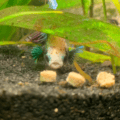
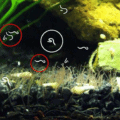
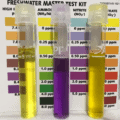
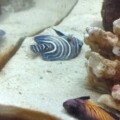


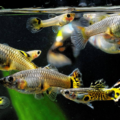


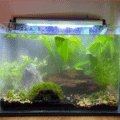
28 thoughts on “7 Best Filters for Your Turtle Tank & its Gallon Capacity”